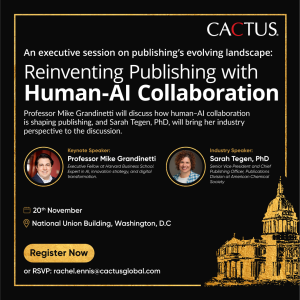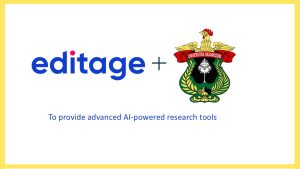A journal editor’s role has become more demanding than ever. From managing the constant inflow of manuscript submissions, tight deadlines, the pressure to ensure zero ethical slip-ups, and other administrative tasks, their task lists seem never-ending. Add to this the rising threat of paper mills and the increasing frequency of headline-making retractions, and maintaining the integrity of scientific publications has become even more complicated.
The rise of AI tools in editorial workflows
As the publishing industry continues to evolve and create policies to safeguard the integrity of published research, artificial intelligence (AI) tools have come up as a viable option in offering reliable assistance to editorial teams in managing their responsibilities. The use of AI in academic publishing workflows isn’t hypothetical anymore.
As Aashi Chaturvedi, Program Officer for Ethics and Integrity at the American Society for Microbiology noted, with the pace of science accelerating, AI can “help alleviate some burden” on reviewers and publishers dealing with high volumes of submissions. Many major publishers, including Springer Nature and Wiley, are already integrating AI tools into their editorial systems to streamline decision-making and uphold research integrity. But are they replacing editors? No, far from it. These tools are designed to be invaluable assistants to journal editorial teams so that editors can focus on high-level decision-making. These tools are capable of managing a range of checks while offering a higher level of scrutiny. Here’s a closer look at how AI is reshaping editorial workflows:
- Screening manuscripts for initial checks: Each year, millions of manuscripts are submitted to journals worldwide. In 2024, Springer Nature alone reported receiving over 2.3 million submissions, resulting in the publication of just over 482,000 articles. This volume underscores both the scale of academic publishing and the critical role of rigorous screening and review. Once a manuscript is submitted to a journal, it enters a multi-stage review process, beginning with an initial screening to assess its suitability for further evaluation. This first check helps sift out submissions that don’t meet basic journal requirements, making it easier for editors to decide whether a paper is ready to move forward to the next stage of evaluation. AI tools can play a critical role, quickly scanning papers to spot issues, saving editors valuable time on routine manual checks. That way, they can focus on the content of the manuscript.
- Detecting instances of plagiarism: One of the most routine but critical steps in editorial workflows is checking for plagiarism. In a global survey, editors estimated that around 15% of manuscript submissions contained plagiarized content and reported personally encountering plagiarism in 2–5% of submissions, underscoring the need for rigorous screening processes. That’s where AI tools like iThenticate come in, scanning manuscripts for text similarities against massive datasets of scholarly content, and flagging anything that looks suspicious. Such AI tools make it easier for editors to manage large volumes of submissions without compromising on quality. But spotting text overlaps is just the start; deciding whether it actually counts as plagiarism isn’t always straightforward, and that’s where an editor’s judgment is essential. While the final decision must be taken by editors, AI offers key assistance.
- Detecting paper mill activity: Major scientific publishers have retracted hundreds to over a thousand paper mill articles in recent years, reflecting the growing strain that these fraudulent submissions are placing on the already overwhelmed academic publishing system. Moreover, paper mills are becoming more sophisticated; thanks in part to advances in AI, the fake research papers are now more convincing than ever. For editors, telling the difference between a genuine submission and a well-disguised fake paper can become a high-stakes guessing game. But AI-powered integrity tools can provide efficiency at scale. Paperpal Preflight for Editorial Desk, for example, has research integrity checks at its core, which includes detecting paper mill activity by analyzing factors like unusual authorship patterns, suspicious content, questionable citations, and duplicated images. It’s an extra layer of defense for editors navigating an increasingly complex landscape.
- Identifying image manipulation: Image manipulation is another growing threat to research integrity and can be notoriously difficult to detect. A 2016 study reported that a review of more than 20,000 peer-reviewed papers found nearly 4% contained problematic images, with about half of those cases suggesting intentional manipulation. While not all cases are intentional, they still raise serious questions about a study’s validity. With submission volumes climbing and time constraints, spotting these issues on time can be a challenge for editors. When these issues come to light after publication, a journal’s reputation and editorial credibility may come under the scanner. Publishers are now using AI tools to scan for signs of duplication or manipulation at scale. These tools analyze patterns across submissions, flagging anything suspicious and helping editors take the final decision.
Impact on journal editorial teams
With AI tools, journals can automate tedious, time-consuming tasks in the publication workflow, like checking references, scanning for disclosure statements, and flagging content irregularities. AI directly reduces the pressure on editors who often juggle hundreds of submissions. The result? An added layer of integrity checks, a stronger editorial process overall, and more time for editors to focus on decisions that truly require their expertise.
Another huge benefit such automation offers is that it can speed up workflows. AI-assisted checks significantly cut down on processing time compared to manual efforts. Journals can adopt more streamlined processes and respond to authors faster without cutting corners. More importantly, because these tools also add checks and safeguards for detecting integrity issues like plagiarism or flawed images, quality control is strengthened alongside enhancing efficiency.
Maintaining the human touch
AI is powerful, no doubt, but it’s not flawless. Like any tool, it can miss context, make mistakes, and even carry bias. That’s why human oversight is essential. While AI-powered tools can lighten the load and support editorial decisions, they should be viewed as partners and not a replacement for human editors. The experience, ethical reasoning, and ability to understand nuances that editors possess are irreplaceable. When used responsibly, with clear guidelines and proper training, AI can be a strong ally, helping uphold integrity without replacing the human touch at the heart of it all.
With Paperpal Preflight for Editorial Desk, we bring together cutting-edge AI and human insight to help journal editorial teams navigate complex publishing workflows. Contact us to explore how we can support your team.









